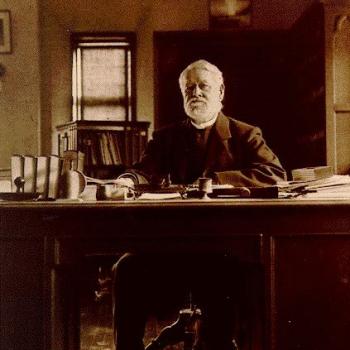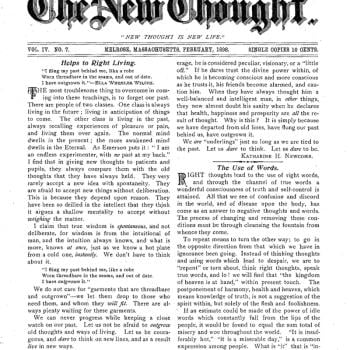In my last column, I mentioned the New Thought movement of the early twentieth century, less for its own intrinsic significance, than for the astonishing importance that observers attached to it. Many educated people saw it as the coming world religion, most notably William James. Today, there is a more basic question: what on earth was it?
The story begins with the Mind Cure movements of nineteenth century New England, which had their best known representative in Mary Baker Eddy and Christian Science But Eddy had plenty of counterparts and would be imitators, including dissident Christian Scientists and pupils of the prophetic Phineas Quimby. Such thinkers explored the same range of ideas, which collectively flourished as the “Boston craze” of the 1880s. Former Eddy student Emma Curtis Hopkins founded the movement that would later be known as New Thought. The various emerging groups held national gatherings through the 1890s, culminating in a national convention in 1899. An International New Thought Alliance was formed in 1914, and by the 1940s, some eighteen distinct New Thought sects and churches were operating, bearing names like the Institute of Religious Science, Metaphysical School of Health, and Church of Advanced Thought. A few of these movements went on to success in their own right. Among the more influential were Divine Science and the Unity School, both of which date from 1889. Under the leadership of Charles and Myrtle Fillmore, Unity flourished through its exploitation of modern techniques of marketing and advertising.
Among its founding principles, declared in 1916, the New Thought Alliance listed “To teach the infinitude of the Supreme One; the Divinity of Man and his Infinite possibilities through the creative power of constructive thinking and obedience to the voice of the Indwelling Presence, which is our source of Inspiration, Power, Health and Prosperity.”
Though agreed on many basic principles, the various therapeutic schools differed as to the relationship of mind and matter: New Thought groups believed in the paramount role of mind in controlling matter, while Christian Science preached an absolute idealism, altogether denying the existence of matter. For Eddy, “Mortal existence is a dream; mortal existence has no real entity, but saith, ‘It is I’.” Still, the schools were at one on fundamentals, in their optimism, and the belief in the divinization of humanity. They also gave a powerful role to women, and extolled women’s spirituality.
A healthy mind and body were to be achieved by recognizing the oneness of our human lives with the life of God, a point suggested by the title of Ralph Waldo Trine’s best-selling In Tune With The Infinite (1897). If men and women all partook of the divine, could they not in a sense claim to be God? Or to quote Trine, “There is no separation between your soul and the soul of the universe. In the deepest sense, you are the great universal soul… Man is God incarnate.”
New Thought was syncretistic, and as William James remarked,
One of the doctrinal sources of Mind-cure is the four Gospels; another is Emersonianism or New England transcendentalism; another is Berkeleyan idealism; another is spiritism, with its messages of “law” and “progress” and “development”; another the optimistic popular science evolutionism of which I have recently spoken; and, finally, Hinduism has contributed a strain. But the most characteristic feature of the mind-cure movement is an inspiration much more direct. The leaders in this faith have had an intuitive belief in the all-saving power of healthy-minded attitudes as such, in the conquering efficacy of courage, hope, and trust, and a correlative contempt for doubt, fear, worry, and all nervously precautionary states of mind.
By spiritism, he means what we would call Spiritualism.
Though New Thought prefigured modern-day therapy movements, it was also rooted in older ideas: “with its constant thought of prosperity, its opulent-consciousness, its belief in the limitless possibilities of the individual, [it] is simply American psychology on dress parade.” As a rationalist critic remarked, dryly, “Their doctrine is ‘Be your own savior; don’t ask someone else to do it for you’. Isn’t this American independence?” Its modern heirs would certainly include Prosperity theology and, indirectly, the “Power of Positive Thinking.” Also lots of New Agey motifs, including “Noetic Science.”
This combination of the familiar and the exotic proved irresistible, so that Christian Science and New Thought ideas became a national presence. Although New Thought began in New England, but it was imported to Los Angeles about 1904, and from about 1915, most of the New Thought leaders established institutions on the Pacific coast. George Wharton James accurately spoke of California as “the natural home of New Thought.” To quote California writer Carey McWilliams, “these two imported movements – Theosophy and New Thought – constitute the stuff from which most of the later creeds and cults have been evolved … the mystical ingredients came from Point Loma; the practical money-mindedness from the New Thought leaders.”
For both strands of the emerging tradition, the year 1915 proved a crucial turning point. This marked the twin great Expositions in San Francisco and San Diego, and San Francisco’s Panama-Pacific International Exposition actively promoted New Thought as the religious vanguard of the new century. This was indeed the setting for the First International New Thought Congress.
If New Thought had become more celebrated, last year would have marked a great centennial, as in fact it did not. New Thought may linger on, but on a far smaller scale than anyone expected a century ago. Still, if we do trace its wider impact, especially through the Prosperity Gospel, then it assuredly demands our attention. It is especially important if we want to understand the religious and cultural history of Progressive-era America.
For a while back there, it was the future.
Some books on the topic include:
John S. Haller, Jr., The History of New Thought (2012)
Gail M. Harley, Emma Curtis Hopkins : Forgotten Founder of New Thought (2002)
Gail Parker, Mind Cure in New England (1973).












